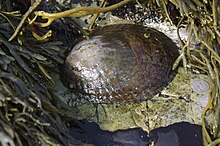
A tide pool or rock pool is a shallow pool of seawater that forms on the rocky intertidal shore. These pools typically range from a few inches to a few feet deep and a few feet across. Many of these pools exist as separate bodies of water only at low tide, as seawater gets trapped when the tide recedes. Tides are caused by the gravitational pull of the sun and moon. A tidal cycle is usually about 25 hours and consists of one or two high tides and two low tides.

The intertidal zone or foreshore is the area above water level at low tide and underwater at high tide: in other words, the part of the littoral zone within the tidal range. This area can include several types of habitats with various species of life, such as seastars, sea urchins, and many species of coral with regional differences in biodiversity. Sometimes it is referred to as the littoral zone or seashore, although those can be defined as a wider region.

The Patellogastropoda, common name true limpets and historically called the Docoglossa, are members of a major phylogenetic group of marine gastropods, treated by experts either as a clade or as a taxonomic order.

Intertidal ecology is the study of intertidal ecosystems, where organisms live between the low and high tide lines. At low tide, the intertidal is exposed whereas at high tide, the intertidal is underwater. Intertidal ecologists therefore study the interactions between intertidal organisms and their environment, as well as between different species of intertidal organisms within a particular intertidal community. The most important environmental and species interactions may vary based on the type of intertidal community being studied, the broadest of classifications being based on substrates—rocky shore and soft bottom communities.
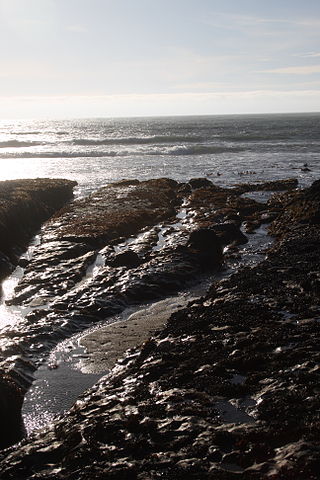
The Davenport Tide Pools are located just past the town of Davenport, California in the United States. They are located off Davenport Landing, which is a street off Highway 1. The tide pools are unique due to the ridges that run up and down the tide pools, allowing for different organisms to live close, even though in a normal habitat they would be unable to do so. The Beach is open sunrise to sunset, and is day use only.
Mesograzers are defined as small invertebrate herbivores less than 2.5 cm in length, and can include juveniles of some larger species. The feeding behaviour of these small invertebrate herbivores is what classifies them as mesograzers. They are commonly found abundantly on Microalgae, seagrass beds, giant kelp, and coral reefs globally, since these are their main food sources and habitats. Their foraging behaviour is grazing on the organism they are living on, where there are typically masses reaching tens of thousands of mesograzers per meter of habitat. They experience predation from micro-carnivorous fish that help regulate the population of kelp and other common food sources of mesograzers by controlling the population of mesograzers; consequently, grazing is an important process linking aquatic vegetation to higher trophic level. Mesograzers show important top-down effect on marine communities, depending on the diversity and presence of predators. Mesograzers are typically overlooked in scientific research however their foraging effects have been suggested to have extreme effects on the population of their common food sources. They both positively and negatively affect macroalgal performance and productivity through grazing on algal, or through removing epiphytes. Mesograzers typically exist in spaces lacking enemies by inhabiting, therefore consuming, marine vegetation which are defended against more mobile, larger consumers through chemical defenses.

Megabalanus is a genus of barnacles in the family Balanidae. Members of the genus grow to 7 cm (2.8 in) in length and inhabit the lower intertidal zone.

Lottia pelta, common name the shield limpet, is a species of sea snail, a true limpet, a marine gastropod mollusk in the family Lottiidae. It is still designated under its synonym Collisella pelta in many textbooks.

Cellana exarata, common name the black-foot ʻopihi and Hawaiian blackfoot is a species of edible true limpet, a marine gastropod mollusc in the family Nacellidae, one of the families of true limpets. ‘Opihi are significant in Hawaiian history where they have had many uses such as food, tools, and jewelry. They are known as a “fish of death.”

Lottia digitalis, commonly known as the fingered limpet or ribbed limpet, is a species of sea snail, a true limpet, a marine gastropod mollusk in the family Lottiidae. These limpets are usually found on the surface of rocks in the high intertidal region on the coastal fringes of the north-eastern Pacific Ocean.

Lottia persona is a species of sea snail, a true limpet, a marine gastropod mollusk in the family Lottiidae, one of the families of true limpets.

Lottia scabra or the rough limpet is a species of sea snail, a true limpet, a marine gastropod mollusk in the family Lottiidae.
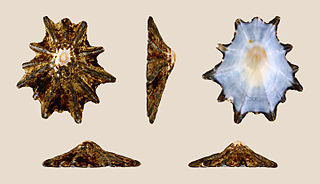
Scutellastra longicosta, the long-spined limpet or the duck's foot limpet, is a species of true limpet, a marine gastropod mollusk in the family Patellidae, one of the families of true limpets. It is native to the coasts of South Africa where it is found on the foreshore. It cultivates a species of crustose brown algae in a "garden".

Diodora funiculata is a species of sea snail, a marine gastropod mollusk in the family Fissurellidae, the keyhole limpets.
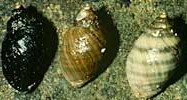
Nucella emarginata, common name the emarginate dogwinkle, is a species of medium-sized predatory sea snail, a marine gastropod mollusk in the family Muricidae, the murex snails or rock snails.

Nucella ostrina, the northern striped dogwinkle, is a species of sea snail, a marine gastropod mollusk in the family Muricidae, the murex snails or rock snails. Other common names for this mollusk include emarginate dogwinkle, short-spired purple dogwinkle, striped dogwinkle, ribbed dogwinkle, emarginate whelk, ribbed rock whelk, rock thais, short-spired purple snail and rock whelk.

Lottia subrugosa is a species of sea snail, a true limpet, a marine gastropod mollusk in the family Lottiidae. It is still designated under its synonyms Acmaea subrugosa or Collisella subrugosa in many textbooks.
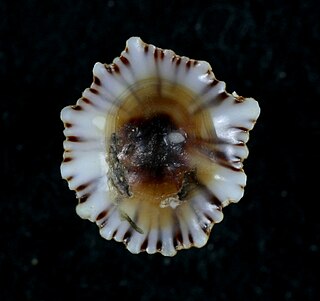
The False 'Opihi or False limpet otherwise known as Siphonaria normalis is an air breathing sea snail that shares its appearance with true limpets. 'Opihi means limpet in Hawaiian. They are part of the Order of Siphonariidae which are known as false limpets. They live in the mid to upper rocky intertidal zone along the coastlines and can be found throughout the Indo-Pacific regions.

Semibalanus cariosus, commonly known as the thatched barnacle, rock barnacle or horse barnacle, is a species of acorn barnacle occurring in the northern Pacific Ocean.

Lottia asmi, commonly known as the black limpet, is a species of sea snail, a marine gastropod mollusk in the family Lottiidae. It is found in shallow water in the eastern Pacific Ocean, usually in the intertidal zone.
